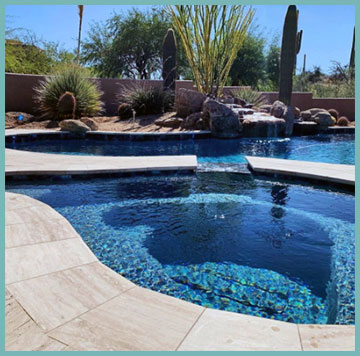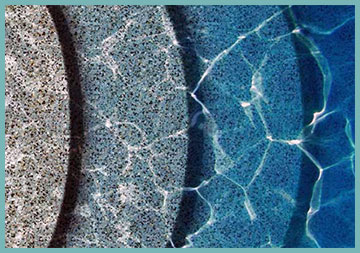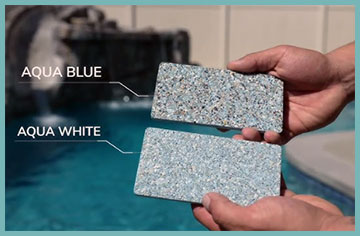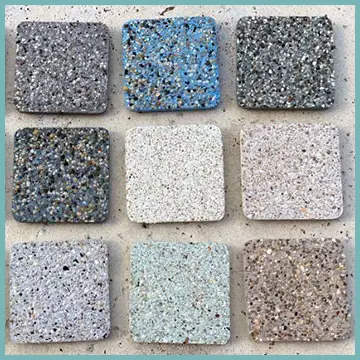Picture this: a shimmering backyard oasis that looks like it was carved from nature itself, durable enough to withstand years of cannonballs and pool parties, and low-maintenance enough to let you spend more time swimming than scrubbing.
That’s exactly what a mini pebble pool finish delivered for me, and I’m convinced it’s the way to go for anyone looking to upgrade their pool. After months of research and living with my own mini pebble pool, I’m here to share why this finish is a game-changer and why you should seriously consider it for your own backyard.
My Journey with a Mini Pebble Pool Finish
When my wife and I decided to renovate our aging pool, we were overwhelmed by the options. Our old plaster finish was cracking and stained, making our backyard look more like a neglected pond than a place to make memories.
We wanted something durable, beautiful, and easy to maintain—because let’s be honest, who has time to babysit a pool? After talking to contractors, reading reviews, and visiting friends’ pools, we landed on a mini pebble finish, specifically PebbleTec’s PebbleSheen in Aqua Blue.

The first thing that struck me when we saw a mini pebble pool in person was the texture.
It wasn’t the rough, rocky surface I’d feared—standard pebble finishes can feel like walking on a gravel driveway—but a smoother, more refined version.
The pebbles, about 1-2 millimeters in size, gave the pool a natural, riverbed-like look that made the water sparkle in a way our old plaster never did.
When we finally got ours installed, the transformation was jaw-dropping.
The light blue water shimmered under the sun, and the subtle mix of white, gold, and brown pebbles gave it a depth that felt luxurious.
Installation wasn’t a breeze, though. It took a skilled crew about three days to apply the finish, and we had to wait a week before filling the pool to let it cure properly. The process involved laying down a base layer of plaster, mixing in the pebbles, and then carefully troweling and washing to expose just the right amount of aggregate.
Our contractor warned us that the quality of the installation crew matters as much as the material itself, and I couldn’t agree more. A sloppy job can leave uneven patches or loose pebbles, so we made sure to hire a certified applicator.
Now, two years into owning our mini pebble pool, I can say it’s been worth every penny. The kids love splashing around without slipping, and I love that I’m not constantly brushing stains like I did with plaster.
Sure, it was pricier upfront—about $10,000 for our 1,200-square-foot pool—but the longevity and low upkeep make it feel like a steal. Every time we host a barbecue, someone comments on how stunning the pool looks, and I can’t help but grin knowing we made the right choice.
Read More: My Thoughts On BOMGIE 0.6HP Pool Pump
Pros of Mini Pebble Pool Finishes
- Unmatched Durability
Let me start with the biggest win: mini pebble finishes last forever—well, almost. With proper care, you’re looking at 20+ years of life, compared to plaster’s measly 7-10 years. The pebbles are natural stone, mixed with cement and high-quality pigments, making them incredibly tough against wear and tear. My pool gets heavy use—kids, dogs, and the occasional inflatable flamingo stampede—and it still looks brand new. Unlike plaster, which cracks and stains like it’s auditioning for a horror movie, mini pebble holds up against harsh pool chemicals and constant sun exposure.
- Stunning Aesthetics
You know that moment when you step into a backyard and the pool just pops? That’s what mini pebble does. The small pebbles create a natural, almost organic look that blends beautifully with any landscape. Whether you go for a light aqua shade like mine or a dramatic black onyx, the water color shifts subtly with the pool’s depth, giving it a dynamic, luxurious vibe. I went with PebbleSheen’s Aqua Blue, and the way it catches the light makes our backyard feel like a resort. Plus, with dozens of color options, you can customize it to match your style, from modern chic to tropical oasis.
- Low Maintenance
Here’s where mini pebble really shines. I used to spend hours brushing our old plaster pool to keep stains and algae at bay. With mini pebble, that’s a distant memory. The textured surface hides minor discoloration and algae better than smooth plaster, so you don’t have to scrub as often. A quick brush once a week and balanced water chemistry keep it looking pristine. I’ve gone months without needing an acid wash, and even then, it’s just to refresh the sparkle. This finish is like the low-maintenance friend who always shows up looking great without trying.
- Slip-Resistant Safety
If you’ve got kids or clumsy friends (no judgment), safety is a big deal. Mini pebble’s slightly textured surface gives better traction than slick plaster, reducing the risk of slips. My kids are constantly running around the pool, and I’ve never had to worry about them skidding into a faceplant. It’s not as rough as standard pebble finishes, which can feel like sandpaper, but it’s just grippy enough to keep everyone steady. This balance of safety and comfort is a huge reason we chose it.
- Eco-Friendly Edge
I didn’t expect this, but mini pebble finishes have a green side. The natural pebbles are often sustainably sourced, and the long lifespan means you’re not resurfacing every few years, saving resources. Plus, the smooth surface improves water circulation, which can cut down on chemical use and energy costs. It’s not like I’m saving the planet single-handedly, but it feels good knowing my pool isn’t a resource hog.
Cons of Mini Pebble Pool Finishes

- Higher Upfront Cost
Let’s not sugarcoat it: mini pebble isn’t cheap. For our pool, we paid about $10 per square foot, compared to $4 for plaster. That’s a big jump, especially for larger pools. If you’re on a tight budget, the sticker shock can sting. But here’s my take: you’re paying for quality and longevity. Plaster might save you money now, but you’ll be shelling out for resurfacing sooner. Mini pebble’s durability makes it a smarter long-term investment, but you need to be ready for the initial hit.
- Slightly Rough Texture
While mini pebble is smoother than standard pebble, it’s not as silky as plaster. If you or your kids have super sensitive feet, you might notice the texture, especially during long swim sessions. I’ve heard some folks complain about abrasions, though we’ve never had an issue. My advice? Try out a mini pebble pool before committing. Sit on the steps, walk around, and see how it feels. For us, the slight roughness is a fair trade for the durability and grip.
- Installation Complexity
Getting a mini pebble finish right requires skill. A bad installer can leave you with uneven patches, loose pebbles, or blotchy colors. We were lucky to find a certified applicator, but I’ve read horror stories about shoddy jobs that needed fixing within a year. This isn’t a DIY project, and you’ll need to vet your contractor carefully. Ask for references, check their certifications, and maybe even visit a pool they’ve done. It’s a hassle, but it’s worth it to avoid headaches later.
- Potential for Calcium Buildup
Mini pebble is less prone to staining than plaster, but it’s not immune to calcium or mineral buildup, especially if your water chemistry is off. I’ve noticed some light scaling on our pool’s steps, which required a mild acid wash to clean up. It’s not a dealbreaker, but you need to stay on top of your pH, alkalinity, and calcium levels to prevent it. If you’re not diligent, those pebbles can start looking a bit cloudy.
Maintenance Tips for Mini Pebble Pool Finishes

- Keep Your Water Chemistry Balanced
Your pool’s finish is only as good as the water it’s in. I learned this the hard way when our pH crept too high and we got some scaling. Test your water weekly for pH (7.2-7.6), alkalinity (80-120 ppm), and calcium hardness (200-400 ppm). A good test kit is your best friend—I use a digital one for accuracy. If something’s off, adjust it pronto with the right chemicals. Balanced water keeps your mini pebble looking vibrant and prevents etching or buildup.
- Brush Weekly, but Don’t Overdo It
Brushing your pool once a week is enough to keep algae and debris from settling into the pebbles. Use a nylon-bristle brush—stiff enough to clean but gentle enough not to damage the finish. I spend about 15 minutes brushing the walls and steps, focusing on high-traffic areas. Don’t go crazy with the scrubbing; the textured surface doesn’t need as much elbow grease as plaster. Over-brushing can wear down the finish over time.
- Schedule Occasional Acid Washes
Every year or two, an acid wash can bring back that showroom shine. Our contractor did one after the first year, and it made the pebbles sparkle like new. You’ll need a professional for this—mixing acid is not a DIY job unless you want to risk your finish (or your safety). They’ll drain the pool, apply a diluted acid solution, and rinse it thoroughly. It’s a bit of an investment, but it extends the life and beauty of your finish.
- Invest in a Good Filtration System
A strong filtration system keeps your water clear and reduces strain on the finish. We upgraded to a variable-speed pump, and it’s been a game-changer for water circulation and chemical efficiency. Run your filter 8-12 hours a day, depending on pool use, and clean it regularly. Clear water means less chance of algae or buildup sticking to your pebbles. It’s a small upfront cost for years of easier maintenance.
- Watch for Algae in Crevices
Mini pebble hides algae better than plaster, but it can still lurk in the tiny gaps between pebbles. If you notice green or black spots, hit them with a targeted dose of chlorine and scrub gently. I had a stubborn algae patch last summer that took a couple of weeks to fully clear. Stay proactive—regular shocking and good circulation prevent algae from taking hold in the first place.
Comparing Mini Pebble to Other Brands
When I was shopping around, I looked at several brands: PebbleTec, StoneScapes, Wet Edge, and CLI Industries. Here’s how they stack up against mini pebble, based on my experience and research.

- PebbleTec is the gold standard, and it’s what we chose. Their PebbleSheen line, a mini pebble finish, is renowned for consistent quality and vibrant colors. They use high-quality, fade-resistant pigments and a rigorous manufacturing process that screens out impurities. The downside? It’s pricier—expect $8-$12 per square foot. But their certified applicators and double warranty (product and workmanship) gave me peace of mind. If you want reliability and a premium look, PebbleTec is hard to beat.
- StoneScapes, by NPT, is a close competitor. Their Mini Pebble line is slightly more affordable—around $6-$10 per square foot—and offers a similar natural aesthetic. I loved their Tahoe Blue with abalone shells for extra sparkle, but I heard mixed reviews about color consistency. Some homeowners reported blotchiness, which scared me off. If budget is a concern and you find a top-notch installer, StoneScapes is a solid choice.
- Wet Edge, another player, focuses on polished finishes like Luna Quartz, which are smoother than most mini pebbles. Their St. Maarten blend caught my eye for its glossy look, but some users mentioned staining from metal objects left in the pool. It’s in the same price range as StoneScapes, but I worried about the long-term durability of their quartz-based finishes compared to pebble. If you prioritize smoothness, it’s worth a look, but check installer credentials.
- CLI Industries offers finishes like Krystalkrete, which blend quartz and pebble. They’re durable and customizable, but I found fewer color options compared to PebbleTec or StoneScapes. Pricing is similar to StoneScapes, but their warranty terms weren’t as clear, which made me hesitant. If you’re after something unique, CLI might work, but it’s less common, so finding an experienced applicator can be tricky.
Ultimately, I went with PebbleTec’s PebbleSheen because of their reputation and the stunning Aqua Blue finish. StoneScapes is great for budget-conscious folks, Wet Edge for those wanting a polished look, and CLI for something a bit different. But for me, PebbleTec’s quality and consistency won out.
Read More: My Thoughts On Mohawk SolidTech Select Flooring
Frequently Asked Questions (FAQ)
With proper maintenance, a mini pebble pool finish can last 20-25 years or more. Its durability comes from the natural stone pebbles and high-quality cement mix, which resist cracking and staining far better than plaster. I’ve had mine for two years, and it looks as good as the day it was installed. Regular water chemistry checks and occasional brushing are key to hitting that two-decade mark.
Absolutely, if you value longevity and aesthetics. Mini pebble costs more upfront—$8-$12 per square foot versus $4 for plaster—but it lasts three times as long and requires less maintenance. My pool’s vibrant look and easy upkeep have made it worth every cent. If you’re on a tight budget, plaster might be tempting, but pebble’s durability saves money in the long run.
A mini pebble pool finish is a blend of small (1-2 mm) natural pebbles mixed with cement and pigments, applied to a pool’s interior. It creates a durable, textured surface that’s smoother than standard pebble but grippier than plaster. The result is a natural, riverbed-like look with vibrant water colors. Ours is PebbleSheen Aqua Blue, and it’s like swimming in a tropical lagoon.
PebbleTec’s main drawbacks are cost ($8-$12 per square foot), a slightly rougher texture than plaster, and the need for skilled installation. Some users report abrasions on sensitive skin, though I haven’t experienced this. Calcium buildup can occur if water chemistry isn’t maintained, and poor applicators can leave uneven surfaces. Despite these, I find PebbleTec’s durability and beauty outweigh the cons.
Conclusion: My Mini Pebble Love Affair
Two years in, I’m still head over heels for our mini pebble pool finish. It’s transformed our backyard into a showpiece that’s both gorgeous and practical. The durability means I’m not stressing about resurfacing anytime soon, and the low maintenance lets me focus on enjoying the pool with my family. Sure, it cost more upfront, and we had to be picky about our installer, but the payoff has been incredible. If you’re ready to elevate your pool game, mini pebble is the way to go. Trust me—you won’t regret it.
